Frogs are fascinating animals with importance to people and the environment. They control garden pests such as insects and slugs. They also serve as a food source for many larger wildlife species. In addition, frogs have been essential to several medical advances that help humans. Research on the substances frogs secrete through their skins has led to the creation of new painkillers and antibiotics.
Most frogs in Florida are reclusive and harmless to humans, but two species of frogs that have invaded Florida can be harmful to people and their pets. In this document, we present some facts about native frogs, describe the problems invasive frogs cause, and provide suggestions on how to cope with problem frogs.
Getting to Know Frogs
- There are approximately 7,700 species of frogs worldwide. About 30 species of frogs breed in Florida, most of which are native, but 4 species have been introduced by people.
- Frogs have a unique body design with long, powerful rear legs for jumping, a short backbone, and a large head with a wide mouth.
- All of Florida's native frogs lay their eggs in water. Tadpoles hatch from the eggs, grow, and eventually experience a major metamorphosis as they transform into the adult form. The amount of time a frog spends in the tadpole stage depends on the species of frog, the temperature of the water, and the availability of food. However, the greenhouse frog, which was accidentally introduced to Florida about 150 years ago, lays small clusters of eggs on land, and a tiny version of the adult hatches from the egg—there is not a tadpole.
- Male frogs call (croak) to attract females to mate with. Most Florida frogs breed in the spring and summer, but several species breed during the winter, among them the spring peeper (Pseudacris crucifer) and the southern leopard frog (Lithobates sphenocephalus).
- All toads and frogs are in the same order (Anura). A toad is a specific type of frog and in North America, toads have drier, wartier skin than other frogs. Toads' egg-laying behavior is different from that of other frogs. They lay their eggs in long strands, whereas other frogs lay eggs one at a time or in clumps or floating films.
- It is not true that you can get warts from touching a toad or frog or from accidentally contacting the urine of one of these animals. Warts on human skin have no association with toads or frogs.
- Frogs provide benefits to humans and natural ecosystems. They consume insect pests and keep their natural ecosystems healthy by serving as predators and prey.
- Many of Florida's native frogs are common in residential areas. The presence of native frogs around your home is an indication that your yard is "Florida Friendly" (https://ffl.ifas.ufl.edu).
- Frog populations have been declining rapidly worldwide during the past three decades, and many species have gone extinct. The causes of these declines and extinctions include disease, habitat loss, environmental contamination, impacts of invasive species, and climate change.
- Florida has four species of non-native, introduced frogs: the greenhouse frog (Eleutherodactylus planirostris) (Figure 1), the Cuban treefrog (Osteopilus septentrionalis) (Figure 2), the cane toad (Rhinella marina), also known as the bufo toad (Figure 3), and the tropical clawed frog (Xenopus tropicalis). These pest frogs thrive in suburban neighborhoods, agricultural areas, and sometimes natural habitats.
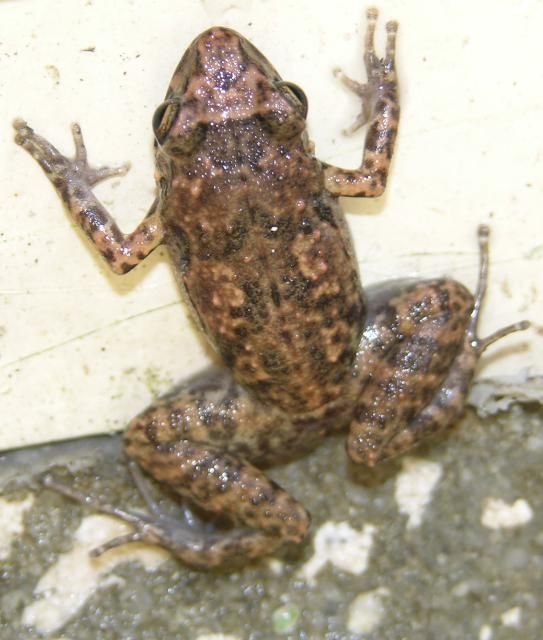
Credit: Steve Johnson, UF/IFAS
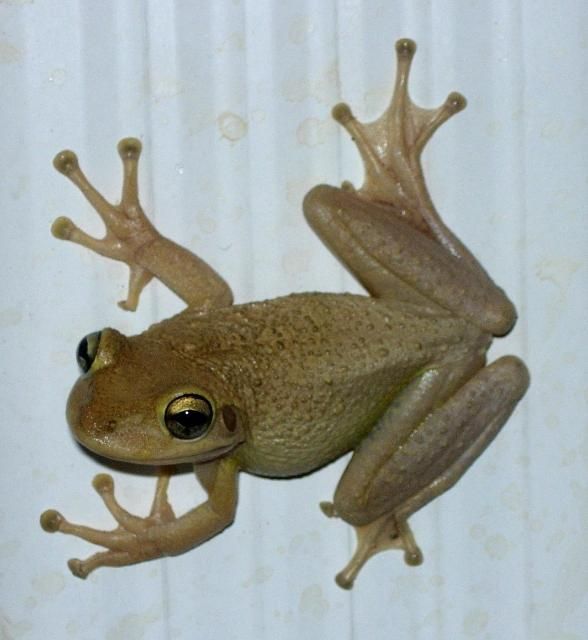
Credit: Steve Johnson, UF/IFAS
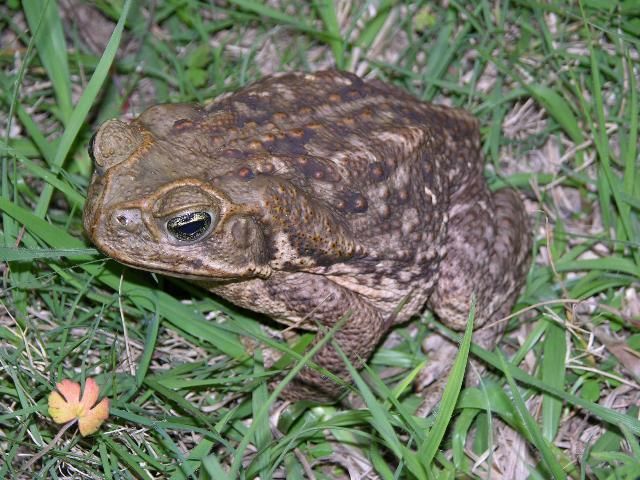
Credit: Steve Johnson, UF/IFAS
- Introduced frogs can be identified and distinguished from native frogs by their colors and marking patterns and by their calls (https://ufwildlife.ifas.ufl.edu/frogs/florida.shtml).
Potential Risks and Damages Associated with Frogs
- Two of Florida's introduced species of frogs, Cuban treefrogs and cane toads, are invasive. These frogs are potentially dangerous to people and pets. They may also be a nuisance and reduce people's quality of life.
- Cane toads and Cuban treefrogs are voracious predators that eat a wide variety of native animals (mainly insects). Cane toads are known to eat small native snakes, and Cuban treefrogs prey upon Florida's native treefrogs. Cane toad eggs, toadlets, and adults are all poisonous and may be toxic to native wildlife.
- Cane toads are potentially toxic to dogs. They secrete a potent poison from large glands (parotoid glands) located in their shoulder regions (Figure 4). Cane toads are able to ooze toxin from their poison glands if they feel threatened, but under the pressure of a dog's bite, the poison squirts from these glands into the dog's mouth. Although native toads also have parotoid glands, they are much smaller than the glands of cane toads. Native toads are not a threat to pets or people.
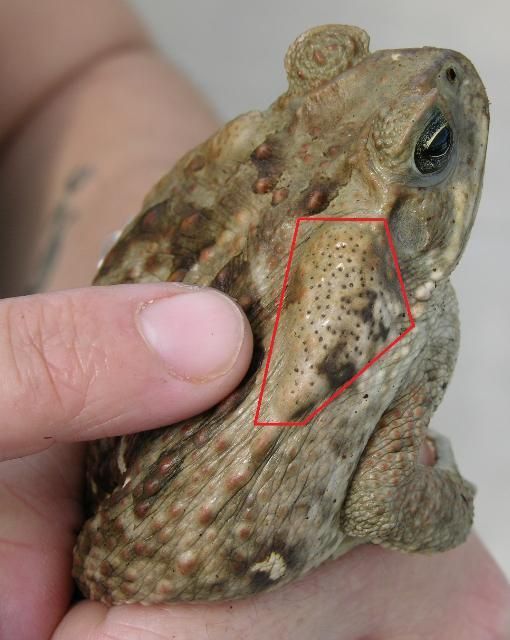
Credit: Steve Johnson, UF/IFAS
- Cane toad toxin can cause extreme irritation and possibly temporary blindness in humans if it gets in your eyes.
- Cuban treefrogs exude a noxious secretion from numerous small glands on their backs, especially when they are handled or harassed. Although they can legally be sold in pet stores, Cuban treefrogs are unsuitable as pets because their toxic mucus can burn the eyes and trigger allergic or asthmatic reactions. The secretions of Cuban treefrogs are extremely irritating to mucous membranes and cause an intense burning sensation in the eyes.
- Cuban treefrogs are known to invade homes through open doors or windows, inadvertently being brought inside while hiding on a potted plant or outdoor furniture, and through vent stacks on the roof of a home (the vents that allow toilets to flush and sinks to drain).
- Cuban treefrogs also invade electrical equipment, such as outside A/C units and pumps. They may cause short circuits and damage to electrical equipment.
- Cuban treefrogs and cane toads make loud breeding calls. Although some people like these sounds, others find them to be so loud that they prevent a good night's sleep.
- Cuban treefrogs may interfere with the breeding of native frog adults, and their tadpoles are known to have a negative effect on tadpoles of some native species.
How to Prevent Risks and Damage from Invasive Frogs
- Learn to identify cane toads and Cuban treefrogs; several species of native treefrogs and toads can be easily confused with the two invasive species (https://ufwildlife.ifas.ufl.edu/frogs/canetoad.shtml and https://edis.ifas.ufl.edu/uw346).
- Capture cane toads and Cuban treefrogs by hand and with traps. Wear gloves or place a plastic grocery bag over your hand when capturing these frogs by hand. Be decisive and swift when grabbing these frogs. PVC pipes can be set in your yard to capture and remove Cuban treefrogs (Figure 5 & Video 1).
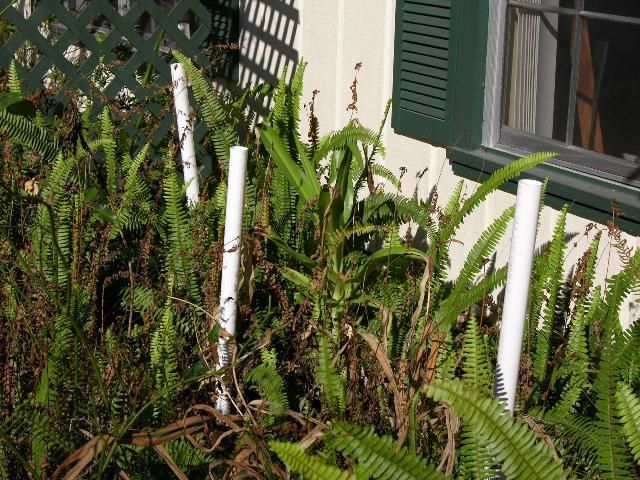
Credit: Steve Johnson, UF/IFAS
Credit: UF/IFAS video featuring Steve Johnson
- Humanely euthanize captured cane toads and Cuban treefrogs by liberally applying a benzocaine- or lidocaine-based ointment or spray (e.g., tooth ache gel, sunburn relief spray) to the frog's belly to anesthetize it. After 10 to 15 minutes, secure the frog in a plastic sack and place in your freezer overnight (Figure 6). Alternatively, a captured cane toad or Cuban treefrog can be secured in a plastic bag, placed in a refrigerator for 2-3 three hours, and then transferred to a freezer overnight. The cool temperature of the fridge acts as an anesthetic, similar to benzocaine ointment. Dispose of frozen frogs with your garbage.
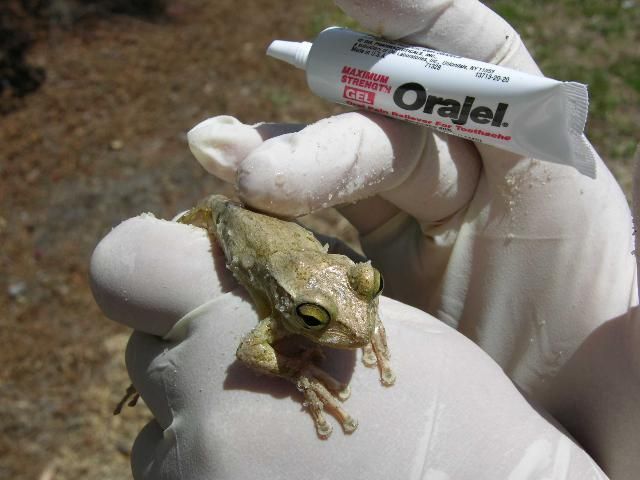
Credit: Steve Johnson, UF/IFAS
- Do not translocate frogs elsewhere. Like homing pigeons and many cats and dogs, frogs can find their way back to their original location after being displaced. Therefore, turning frogs loose at another location is not an effective strategy. In addition, it is against Florida state statutes to release a non-native animal in Florida without a permit, so it is against the law to catch and release invasive frogs elsewhere.
- Bring in pet bowls at night. Cane toads will learn to eat pet food left outdoors and will also soak in pet water bowls during dry spells—potentially poisoning your pets' water.
- Accompany pets outdoors at dawn and dusk when cane toads are most active.
- Shut off lights that attract insects to make your home and yard less attractive to cane toads and Cuban treefrogs. Both of these species feed on insects that are attracted to lights.
- Cover roof vent pipes with hardware cloth to prevent entry into buildings by Cuban treefrogs (Figure 7).
- Examine frog eggs laid in standing water that accumulates in structures in your yard. Cane toad eggs will appear as strings, whereas Cuban treefrog eggs will appear as scattered, floating patches. Pour out pooled water that contains tadpoles of these invasive frogs. UF/IFAS county Extension agents and wildlife assistance biologists from Florida Fish and Wildlife Conservation Commission can assist with verification of the identity of eggs and tadpoles from a photo.
- Maintain your swimming pool with regular chlorine and shock treatments. Be sure to maintain proper water pH (~7.5 with a test kit) so chlorine treatments are most effective. Cuban treefrogs will lay their eggs in pools that are not well maintained.
- Habitat modifications can make your yard less attractive to cane toads. Remove debris piles in your yard where cane toads may seek shelter during the day. Trim low-hanging vegetation above the ground to about six inches. Block access to hiding places, such as under A/C units, decks, and around the edges of buildings. Eliminate areas that are constantly damp or wet where cane toads may gather to seek moisture.
- Apply a suitable deterrent such as Sniff-N-Stop (https://sniffnstop.com/) inside A/C units, pump houses, and other enclosed areas to deter Cuban treefrogs (but do not use this product indoors, and follow all manufacturer guidelines).
- Call a professional if you need help with a nuisance frog problem. The Florida Fish and Wildlife Conservation Commission has a list of professionals that deal with nuisance wildlife, listed according to county of operation (https://app.myfwc.com/HGM/NWT/NWTSearch.aspx). Note that hiring a professional is expensive.
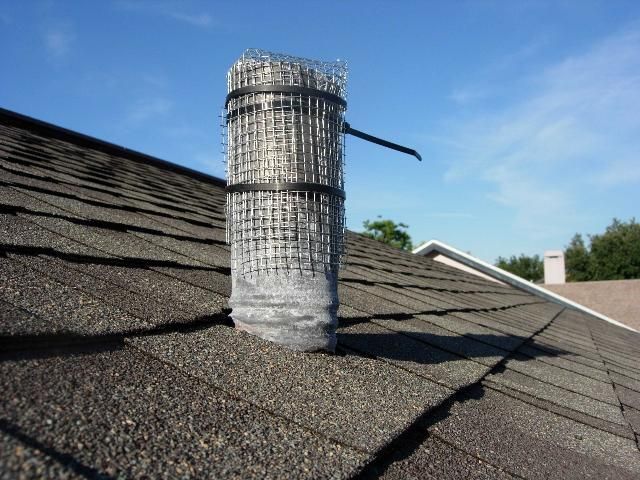
Credit: Steve Johnson, UF/IFAS
More Information
UF/IFAS—Florida Frogs online identification page: https://ufwildlife.ifas.ufl.edu/frogs/florida.shtml
UF/IFAS—The Cuban Treefrog In Florida: https://edis.ifas.ufl.edu/uw259
UF/IFAS—Invasive Cuban Treefrogs website: https://ufwildlife.ifas.ufl.edu/cuban_treefrog_inFL.shtml
UF/IFAS—The Cane or “Bufo” toad in Florida: https://edis.ifas.ufl.edu/publication/UW432